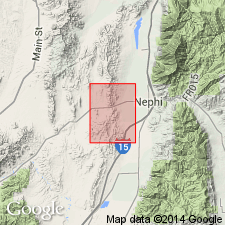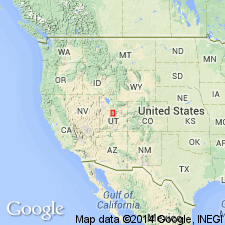
- Usage in publication:
-
- Hall Canyon Conglomerate Member
- Modifications:
-
- Named
- Dominant lithology:
-
- Conglomerate
- AAPG geologic province:
-
- Great Basin province
Summary:
Named as middle member of Goldens Ranch Formation. Best exposures occur northwest and southeast of Hall Canyon in NE1/4 sec 16, T13S, R1W, on east side Long Ridge, Juab Co, UT in the Great Basin province. No type locality designated. Separable into Q and V units. Separable on basis of presence of volcanic clasts. Relationship of units to each other not explained. Unit Q is composed of 60 to 70 percent quartzite clasts and 30 to 40 percent limestone clasts. Unit V is composed of 45 to 55 percent quartzite clasts, 15 percent Paleozoic limestone clasts, and 30 to 40 percent volcanic clasts. Quartzite clasts look like Tintic Quartzite; limestone clasts are from Paleozoic limestone; volcanic clasts are chiefly red andesite. Matrix of both units is bentonitic clay. Is about 250 +/-m thick. Overlies Chicken Creek Tuff Member (stratigraphic rank reduced from formation) of Goldens Ranch. Unconformably underlies Sage Valley Limestone Member of the Goldens Valley. Correlates with part of Ajax and Crazy Hollow Formations. Correlation chart. Assigned an Oligocene age. (B1565)
Source: GNU records (USGS DDS-6; Denver GNULEX).

- Usage in publication:
-
- Hall Canyon Conglomerate Member
- Modifications:
-
- Not used
Summary:
Not used as a member of Goldens Ranch Formation in the Juab-Sevier Valley areas, UT, Great Basin province. Rocks assigned to Hall Canyon by Meibos (1983) called stream-deposited sediments of lower unit of chiefly water-laid sediments of Goldens Ranch Formation (adopted).
Source: GNU records (USGS DDS-6; Denver GNULEX).
For more information, please contact Nancy Stamm, Geologic Names Committee Secretary.
Asterisk (*) indicates published by U.S. Geological Survey authors.
"No current usage" (†) implies that a name has been abandoned or has fallen into disuse. Former usage and, if known, replacement name given in parentheses ( ).
Slash (/) indicates name conflicts with nomenclatural guidelines (CSN, 1933; ACSN, 1961, 1970; NACSN, 1983, 2005, 2021). May be explained within brackets ([ ]).

